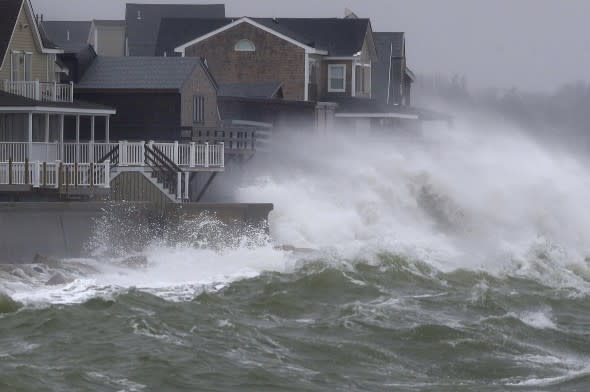Why it's not unusual to see such frequent nor'easters this time of year
Over the first half of March, three separate and powerful nor'easters rattled the mid-Atlantic and Northeast and that number could increase to four later this week.
The storms, which occurred primarily on March 2, March 7 and March 13, shut down travel and left millions of customers without power thanks to blizzard conditions, powerful winds and major coastal flooding.
Many residents didn't even have the chance to finish digging out or get their electric turned back on by the time the next storm was bearing down.
While it might seem unusual for these storms to occur so frequently, having multiple nor'easters this late in the season or over a period of several weeks is not uncommon.

Waves crash against a seawall and houses, Wednesday, March 7, 2018, in Scituate, Mass. (AP Photo/Steven Senne)
The most recent winter season that is reminiscent of this year is 2014-2015. That year had five potent nor'easters bring snow to the Northeast and helped Boston set a new record for snowiest winter on record with over 108 inches.
Three of those storms that winter occurred within the span of a month. The first nor'easter occurred from Jan. 25-28, the second from Jan 29 - Feb. 4 and the third from Feb. 8-11. Of those three storms, the first two were both given a rating of 3, or "major," on the Northeast Snowfall Impact Scale (NESIS).
The winter of 2013-2014 also had five nor'easters but in some winters, such as 2012-2013, only two occurred.
What is notable about this month's trio of storms is how strong they've been, according to AccuWeather Chief Meteorologist Elliot Abrams.
Abrams said the nor'easters gathered more strength because they remained out over the ocean for a longer period of time and had a chance to absorb more energy from the Gulf stream.
The warm waters of the Gulf stream combined with the cold air over the mainland created a tremendous temperature contrast.
Each of these storms underwent bombogenesis, a process in which storms undergo rapid strengthening, and were labeled "bomb cyclones."
The existing weather pattern that has produced these storms may cause more to form in the coming weeks. The same blocking pattern remains thanks to a large area of high pressure near Greenland and eastern Canada.
Abrams explained that in a pattern like this, storms are forced to take a detour, much like motorists circumventing a traffic jam, and head farther south. A storm that passes farther south of Boston gives them a nor'easter because of the direction of the winds.
Abrams explained that nor'easters can happen all winter, but they tend to be more frequent later in the season when there is a bigger contrast between cold air in eastern Canada and the warm air spreading through the Southeast.
The first two nor'easters this month brought heavy snow to much of the interior Northeast, while coastal New England bore the brunt of the third storm.
Note that no two snow storms are ever the same... here are the first three Nor'easters of this month -- the heaviest snow was in a different place every time, though some got hit by more than one storm. pic.twitter.com/jxIax5qZgI
— Jesse Ferrell (@Accu_Jesse) March 15, 2018
"It's not a terribly unusual pattern," Abrams said. "New England is known for its nor'easters."
Donna Childs, a New England resident and author of Prepare for the Worst, Plan for the Best: Disaster Preparedness and Recovery for Small Businesses, was in Cape Canaveral, Florida, attending the launch of the new GOES-S satellite when the first storm was unfolding.
Childs' return flight home on March 2 was actually delayed by the first nor'easter and she withstood the second two from her home, which did not suffer any damage.
With such little time to recover between the three storms, it can overwhelm local preparedness and take a toll on business, Childs said. She added that a loss of power of more than 24 hours to restaurants can result in spoiled food, which results in losses of thousands of dollars.
"For restaurants and other businesses that depend on access, they lose revenue when people are not able to access the roads and patronize their businesses," she said.
When it comes time to prepare, especially when the weather has been so impactful, Childs recommends having protein bars and bottled water handy as well as keeping key electronic devices fully charged.
"I'm just planning for this as a matter of routine this winter because it's been so severe," she said.
